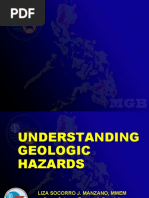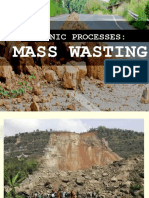Jom Landslide
Jom Landslide
Uploaded by
Princess MirandaCopyright:
Available Formats
Jom Landslide
Jom Landslide
Uploaded by
Princess MirandaOriginal Title
Copyright
Available Formats
Share this document
Did you find this document useful?
Is this content inappropriate?
Copyright:
Available Formats
Jom Landslide
Jom Landslide
Uploaded by
Princess MirandaCopyright:
Available Formats
ROCK SLIDE: A landslide involving bedrock in which the
rock that moves remains largely intact for at least a portion
of the movement. Rock slides can range in size from small
and thin to very large and thick, and are subject to a wide
range of triggering mechanisms. The sliding occurs at the
base of the rock mass along one to several relatively thin
zones of weakness, which are variably referred to as “slide
planes,” “shear surfaces,” “slip surfaces,” “rupture surfaces,”
or “failure surfaces.”
EARTH FLOW: A specific type of Soil Flow landslide where
the majority of the soil materials are fine-grained (silt and
clay) and cohesive. The material strength is low through
much of the slide mass, and movement occurs on many
discontinuous shear surfaces throughout the landslide mass.
This movement along numerous internal slide planes
disrupts the landslide mass leading to cumulative movement
that resembles the flow of a viscous liquid characterized by a
lumpy, or “hummocky” slope morphology. The lower parts of an earth flow usually bulge
outward and are steeper than adjacent slopes.
DEBRIS SLIDE: A slide of coarse-grained soil, most
common in unconsolidated sandy or gravelly units, but also
are common in residual soils that form from in-place
weathering of relatively hard rock. Owing to the granular
constituents, overall strength of the debris slide mass
generally is higher than that of earth flows, but there may be
a very low strength zone at the base of the soil or within
weathered bedrock. Debris slides typically move initially as
shallow intact slabs of soil and vegetation, but break up after
a short distance into falls and flows. Movement of the slide mass as a shallow slab leads to a
smooth, steep, commonly curved scar. The debris is deposited at the base as a loose
hummocky mass, although the deposit may be rapidly removed by erosion.
DEBRIS FLOW: A Soil Flow where the majority of the
materials are coarse-grained (fine sand to boulder size
particles) and non-cohesive. Debris flows are most often
triggered by intense rainfall following a period of less intense
precipitation, or by rapid snow melt. High pore water
pressures cause the soil and weathered rock to rapidly lose
strength and flow downslope. Debris flows can move very
rapidly, at rates ranging from meters per hour to meters per
second and travel relatively long distances, making them a
significant threat to life and property.
ROCK FALL: A landslide where a mass of rock detaches
from a steep slope by sliding, spreading or toppling and
descends mainly through the air by falling, bouncing or
rolling. Intense rain, earthquakes or freeze-thaw wedging
may trigger this type of movement.
Sinkhole in Bantayan Island and Badian, Cebu
Another sinkhole in Sta. Fe town in Bantayan island was found
in July a year ago that constrained families in sitio Dapdap,
Barangay Langub to move. At first, the opening is a few feet
wide yet developed more extensive as per occupants. The
sinkhole was around 40 feet wide and 4 feet profound.
Sinkhole in Kabankalan City, Negros Occidental
Six individuals have allegedly fallen into a 12 feet profound
sinkhole that all of a sudden showed up amidst a ball court in
Purok Jalandoni, Barangay Oringao in Kabankalan City,
Negros Occidental in July lasy year. MGB said the gap might
have been made by water streaming underground. Theu
considered this as a topographical danger.
Baguio City sinkholes
Sinkholes are very basic in Baguio City, which additionally
has no less than seven known issues and various zones
helpless against avalanches. Avalanches could be activated
by a tremor or constant precipitation, which can likewise make
sinkholes wreak devastation.
Since Baguio has one of the 10 most elevated every day
precipitation records on the planet and is gone by a normal of five tornados in a three-year
period, avalanches and sinkhole-related incidents are normal.
Sinkhole in Bohol
The profound opening found in Barangay Cambilan,
Catigbian, Bohol as indicated by Harlans Multimedia
Production who has posted the video in Youtube said it was
because of the 7.2 size quake that struck the territory in
October 2013
Strange Underwater sinkhole of Dadiangas, GenSan
Debacle authorities are still confounded on a profound
opening suspected sinkhole at Purok Tinago, a group of
casual pilgrims in Barangay South Dadiangas, General
Santos City. Neighborhood TV stations have reported that it
abruptly showed up in February this year.
Neighborhood reports said the submerged gap keeps on
eating into the shores and eat their homes. When they
attempted to gauge the profundity of the opening utilizing a
pumpboat grapple, just 20 dipa (spans) were left of the 350
distances of rope.
Sinkholes
A common emotion in many novels is wishing that the ground would open up and
swallow the person whole. While it makes for great literary drama, it can be terrifying the
same happens in real life. Imagine standing on solid ground one minute and tumbling
down a deep hole the other. That is a reality experienced by those who have fallen into
sinkholes. These holes open up suddenly, without any indications of what is to happen.
Understanding how such a hole can appear without any warning may seem difficult, but
in fact is quite simple.
Sinkholes are found all over the world. In the U.S., sinkholes are especially
common in Texas, Alabama, Missouri, Kentucky, Tennessee, Pennsylvania, and Florida,
according to the U.S. Geological Survey.
Causes of Sinkholes
Sinkholes can be natural or man made. Natural sinkholes occur due to erosion or
underground water. They start developing long time before it actually appears. The
ground beneath our feet is not as much of a solid structure as we think it is. The ground
is made from dirt, along with many rocks and minerals. There is water continually
seeping in between the mud, rocks and minerals, as it makes its way down to the ground
water reservoirs. As this happens, the water slowly erodes the rocks and minerals.
Sometimes the flow of water increases to a point when it washes away the underground
structure of the land. And when the structure becomes too weak to support the surface
of the earth, it collapses and opens up a hole. This is how sinkholes are formed.
Humans are also responsible for the formation of sinkholes. Activities like drilling,
mining, construction, broken water or drain pipes, improperly compacted soil after
excavation work or even heavy traffic can result in small to large sinkholes. Water from
broken pipe can penetrate through mud and rocks and erode the ground underneath and
cause sinkholes. Sometimes, heavy weight on soft soil can result in collapse of ground,
resulting in a sinkhole. Sinkholes can also form when the land surface is changed.
Areas that have a bedrock made of limestone, salt deposits or carbonate rock are
most susceptible to erosion and the formation of such holes. These rocks tend to erode
as acidic water passes through them. When rainwater passes through decaying plant
debris, it tend to become more acidic. Over a period of years, overlying sediments
collapse and a sinkhole develops. Sometimes the holes are small, measuring a few feet
wide and ten to fifteen feet deep. Others can be hundreds of miles wide and deep.
However, all of them can be dangerous for those that get caught in them. There are three
major kinds of sinkholes. Their formation is determined by the same geological
processes, barring a few differences.
You might also like
- DRRR PPT 1Document34 pagesDRRR PPT 1Kim Estrebella0% (1)
- Analyze The Causes of Geological HazardDocument13 pagesAnalyze The Causes of Geological HazardDaniel Arradaza100% (1)
- MGB - RAIN-INDUCED LANDSLIDE and FLOODING IN THE PHILIPPINES - Balanga PDFDocument57 pagesMGB - RAIN-INDUCED LANDSLIDE and FLOODING IN THE PHILIPPINES - Balanga PDFLaila Guarin100% (1)
- Geological Hazards Landslides and SinkholesDocument63 pagesGeological Hazards Landslides and SinkholesParadoxistNo ratings yet
- NEW DRRR Lesson 5Document5 pagesNEW DRRR Lesson 5rafhaelsaibo.26No ratings yet
- 1.implement, Keeping and BookkeepingDocument7 pages1.implement, Keeping and BookkeepingantheafeymNo ratings yet
- Mass Wasting (Es)Document11 pagesMass Wasting (Es)Crafty JigyasaNo ratings yet
- Bs Geology, MSC Geotech Eng'G, Mba: Eduardo S. TanDocument83 pagesBs Geology, MSC Geotech Eng'G, Mba: Eduardo S. Tanrinsandesu 27No ratings yet
- DRRR InfographicDocument1 pageDRRR InfographicAllaizah SimsungcoNo ratings yet
- Chapter 6 Other Geological Hazards 1Document5 pagesChapter 6 Other Geological Hazards 1sean.delacruz.3158No ratings yet
- Types of Landslides: Ministry of Lands AND Mineral ResourcesDocument2 pagesTypes of Landslides: Ministry of Lands AND Mineral ResourcesLanz Annnton.No ratings yet
- DRRD Second Quarter NotesDocument17 pagesDRRD Second Quarter NotesNicolle P. PelagioNo ratings yet
- Lecture 3.2 - Landslide and Sinkhole and Other Geological HazardsDocument59 pagesLecture 3.2 - Landslide and Sinkhole and Other Geological HazardsKurt Brandon BautistaNo ratings yet
- Sinkhole Reviewer DRRRDocument2 pagesSinkhole Reviewer DRRRangelamaevillonNo ratings yet
- What Is LandslideDocument10 pagesWhat Is LandslideYuvendran KumarNo ratings yet
- DRRR-G-1 20240929 170659 0000.pptx 20240929 200951 0000Document26 pagesDRRR-G-1 20240929 170659 0000.pptx 20240929 200951 0000reymanclarince32No ratings yet
- DRRR COmpetency 27-30Document11 pagesDRRR COmpetency 27-30Marjorie BrondoNo ratings yet
- Geologic Hazard Group 3.1 PDFDocument65 pagesGeologic Hazard Group 3.1 PDFYap Usis MelsNo ratings yet
- Geohazard PPTN Boy CsoutDocument111 pagesGeohazard PPTN Boy CsoutRonelo HidalgoNo ratings yet
- DRR ReviewerDocument4 pagesDRR ReviewersorerikarubyNo ratings yet
- DRRR?Document10 pagesDRRR?Chris john AlfilerNo ratings yet
- DRRR - Q2 - Week 1Document14 pagesDRRR - Q2 - Week 1Nylinam67% (3)
- D3R 20240407 153642 0000Document6 pagesD3R 20240407 153642 0000ralphclarenceymNo ratings yet
- DRRR-week9Document15 pagesDRRR-week9Zheniceby CabuetelaNo ratings yet
- Rojielynne T. Yusay Grade - 11 AQUILA: Disaster Readiness and Risk Reduction Quarter 2 - Module 6Document6 pagesRojielynne T. Yusay Grade - 11 AQUILA: Disaster Readiness and Risk Reduction Quarter 2 - Module 6Ennyliejor YusayNo ratings yet
- DRRR Reviewer 2-1Document2 pagesDRRR Reviewer 2-1Peter Calvin Bautista Medico IINo ratings yet
- Geological HazardsDocument38 pagesGeological HazardsNikkaNo ratings yet
- Report in Disaster Q3Document10 pagesReport in Disaster Q3joannapiezaNo ratings yet
- Geologic HazardDocument6 pagesGeologic Hazardchloudchloecanta8No ratings yet
- Group 2 - 2202 - Mass MovementDocument46 pagesGroup 2 - 2202 - Mass MovementAnn Gabrielle SuarezNo ratings yet
- SinkholeDocument5 pagesSinkholeSharafa AshleyNo ratings yet
- CONCEPT NOTES 10 Exogenic ProcessDocument7 pagesCONCEPT NOTES 10 Exogenic ProcessClarissa MontoyaNo ratings yet
- Chapter12 Unstable LandDocument12 pagesChapter12 Unstable LandercilloNo ratings yet
- M1 Different Types of Geological Hazards - 083143Document13 pagesM1 Different Types of Geological Hazards - 083143Jamaica AdayNo ratings yet
- MPDF5 - Mass MovementsDocument39 pagesMPDF5 - Mass MovementsMARTIN CRAIG FOZNo ratings yet
- Mass WastingDocument25 pagesMass Wastinganjalimehta202004No ratings yet
- Mass WastingDocument10 pagesMass WastingAbhinav RajeevanNo ratings yet
- DRRR 4th Monthly Test ReviewerDocument7 pagesDRRR 4th Monthly Test ReviewerZuri MaeNo ratings yet
- Mass WastingDocument33 pagesMass WastingNoilyn Sabroso100% (1)
- Mass Wasting PPTDocument33 pagesMass Wasting PPTNoilyn SabrosoNo ratings yet
- GEOLOGICAL HAZARDS ReportingDocument36 pagesGEOLOGICAL HAZARDS ReportingRhean Reyle VelardeNo ratings yet
- DRRR q2 Week 1 Lecture Note 1Document13 pagesDRRR q2 Week 1 Lecture Note 1jeremygalazo0No ratings yet
- Landslide Hazard InformationDocument8 pagesLandslide Hazard Informationgloria tolentino100% (1)
- Erosion and DepositionDocument5 pagesErosion and DepositionJuan RenteriaNo ratings yet
- Exogenic Processes:: Mass WastingDocument55 pagesExogenic Processes:: Mass WastingTricia Mae QuezadaNo ratings yet
- DRRRR ModukeDocument5 pagesDRRRR ModukeRyan BersaminNo ratings yet
- Mass Wasting2Document45 pagesMass Wasting2Rohanpawer PawarNo ratings yet
- DRRR 11 & 12 Module 5.1Document11 pagesDRRR 11 & 12 Module 5.1Ryan BersaminNo ratings yet
- SinkholesDocument3 pagesSinkholesAr Nhel DGNo ratings yet
- Nope IiiDocument7 pagesNope IiiHyun Chong ParkNo ratings yet
- Clasificaciones de Laderas - ImpDocument4 pagesClasificaciones de Laderas - ImpAbrahamNo ratings yet
- Community Preparedness PlanDocument18 pagesCommunity Preparedness PlanJenedil PauloNo ratings yet
- 12 StemDocument27 pages12 StemApril Joy LoreteNo ratings yet
- DRRRQ2 - Module 1 Landslide 2024Document6 pagesDRRRQ2 - Module 1 Landslide 2024Emerald James ZabalaNo ratings yet
- Mass Wasting and LandslidesDocument51 pagesMass Wasting and LandslidesIrish Janine SierraNo ratings yet
- DRRR WordDocument38 pagesDRRR WordLeauvie MendesNo ratings yet
- DRRR PDFDocument39 pagesDRRR PDFLeauvie MendesNo ratings yet
- Earth Science: WeatheringDocument85 pagesEarth Science: WeatheringElijah Raphael YasaNo ratings yet
- Final Exam in StatsDocument6 pagesFinal Exam in StatsPrincess MirandaNo ratings yet
- Final Exam in StatsDocument6 pagesFinal Exam in StatsPrincess MirandaNo ratings yet
- JoyyyDocument2 pagesJoyyyPrincess MirandaNo ratings yet
- Chalice Christian SymbolDocument2 pagesChalice Christian SymbolPrincess MirandaNo ratings yet
- REVIEWERDocument5 pagesREVIEWERPrincess MirandaNo ratings yet
- Combined Competitive (Preliminary) Examination, 2013: Geography Code No. 09Document16 pagesCombined Competitive (Preliminary) Examination, 2013: Geography Code No. 09Milan TiwariNo ratings yet
- Mapa Mundial de Los Sistemas de Alerta de TsunamiDocument1 pageMapa Mundial de Los Sistemas de Alerta de TsunamiJoaquin EnriqueNo ratings yet
- Mjs-065r18kv For Russia Ds 3-0-2Document2 pagesMjs-065r18kv For Russia Ds 3-0-2Claudio Eduardo Mosquera BravoNo ratings yet
- Kunci Soal LatihanDocument7 pagesKunci Soal LatihanAgus SetiawanNo ratings yet
- Let There Be Love ChordsDocument2 pagesLet There Be Love ChordsIndi Rifki JamilNo ratings yet
- Weather&Climatology of TelanganaDocument232 pagesWeather&Climatology of TelanganasrinivasrajuNo ratings yet
- STUDENT BULLETIN TUESDAY 7TH JANUARYDocument5 pagesSTUDENT BULLETIN TUESDAY 7TH JANUARYEshanvi AsthanaNo ratings yet
- Meteorology (All Grades)Document13 pagesMeteorology (All Grades)George CarinoNo ratings yet
- GeologyDocument24 pagesGeologyumair rajputNo ratings yet
- SM 6902Document31 pagesSM 6902mansoor2No ratings yet
- Biology 10th Chapter 2 MCQs - (Sarwaich Encyclopedia - 0309-3934147)Document6 pagesBiology 10th Chapter 2 MCQs - (Sarwaich Encyclopedia - 0309-3934147)Asadullah MaharNo ratings yet
- Form 2 - Geography - Question PaperDocument7 pagesForm 2 - Geography - Question PaperMejah GeoffreyNo ratings yet
- Lightning Arrester PPTDocument20 pagesLightning Arrester PPTRajesh Kumar JenaNo ratings yet
- Grade 6 Science EM Unit 03Document2 pagesGrade 6 Science EM Unit 03suganthi sivanathanNo ratings yet
- 5 FB e 1stDocument5 pages5 FB e 1stYan Hao NamNo ratings yet
- WINDLAOD On ParapetDocument24 pagesWINDLAOD On ParapetMuraleedharanNo ratings yet
- Unit 5 CoursebookDocument12 pagesUnit 5 Coursebookfilippo lunardonNo ratings yet
- Generic Structure Text Significant Language FeaturesDocument1 pageGeneric Structure Text Significant Language FeaturesDewi SantiNo ratings yet
- METAR METeorlogical Aviation Routine Weather ReportsDocument18 pagesMETAR METeorlogical Aviation Routine Weather Reportsloeurmtoeurt10No ratings yet
- Chapter 2 SpillwayDocument83 pagesChapter 2 SpillwayKaseye AmareNo ratings yet
- Lewiston Australia Revised Flood Map 1Document1 pageLewiston Australia Revised Flood Map 1mihai968No ratings yet
- Pakmet Report On Sargodha Bhalwal TornadoDocument8 pagesPakmet Report On Sargodha Bhalwal TornadoGul HanifNo ratings yet
- Water Cycle Water Cycle Oxygen-Carbon Cycle Oxygen-Carbon CycleDocument3 pagesWater Cycle Water Cycle Oxygen-Carbon Cycle Oxygen-Carbon CycleJewo CanterasNo ratings yet
- Activity 1Document1 pageActivity 1edwin fernando joya duarteNo ratings yet
- Unit-1 HWREDocument51 pagesUnit-1 HWREsaikiranreddyg555No ratings yet
- Underground Piping EngineeringDocument4 pagesUnderground Piping Engineeringsammar_10No ratings yet
- Disaster Cause by RainDocument15 pagesDisaster Cause by RainUNCLE STATIONARYNo ratings yet
- The Outer Solar System: NameDocument4 pagesThe Outer Solar System: NameAlle LunagNo ratings yet
- As Conditions and Safe Navigation Permit, Our Suggested Route Remains ValidDocument2 pagesAs Conditions and Safe Navigation Permit, Our Suggested Route Remains ValidIonut GabrielNo ratings yet
- Synoptic MeteorologyDocument40 pagesSynoptic Meteorologyyazqa100% (1)






























































































